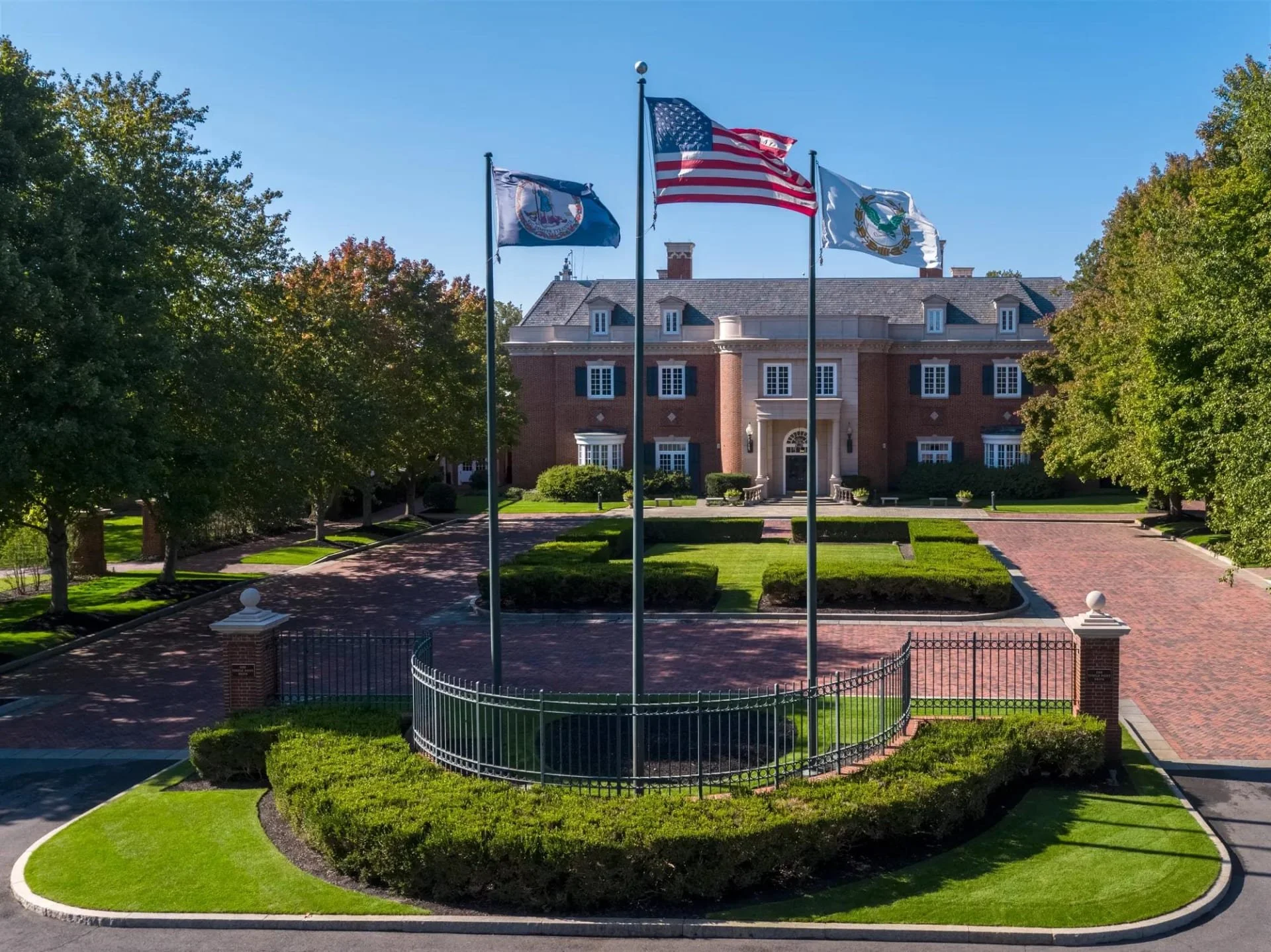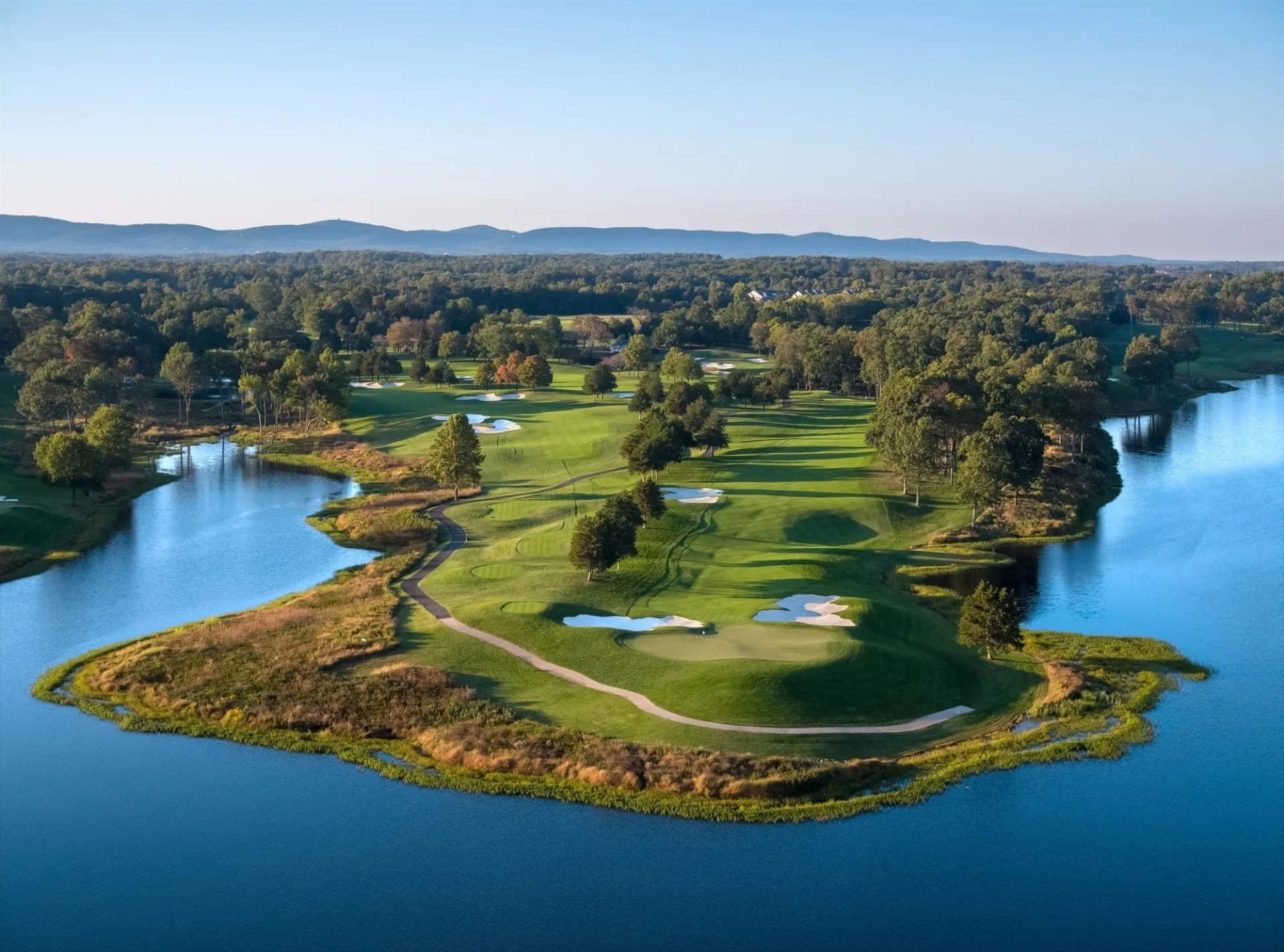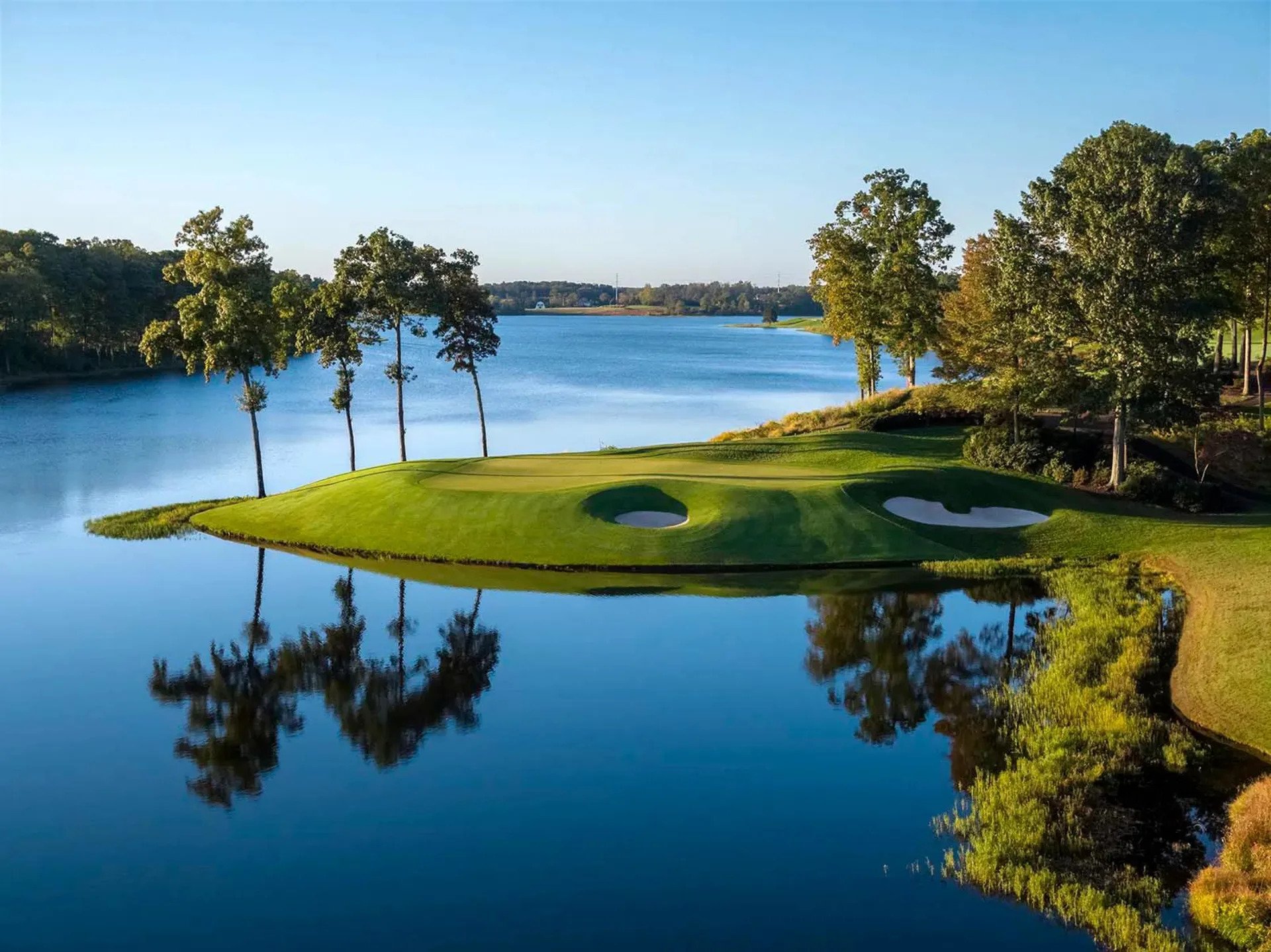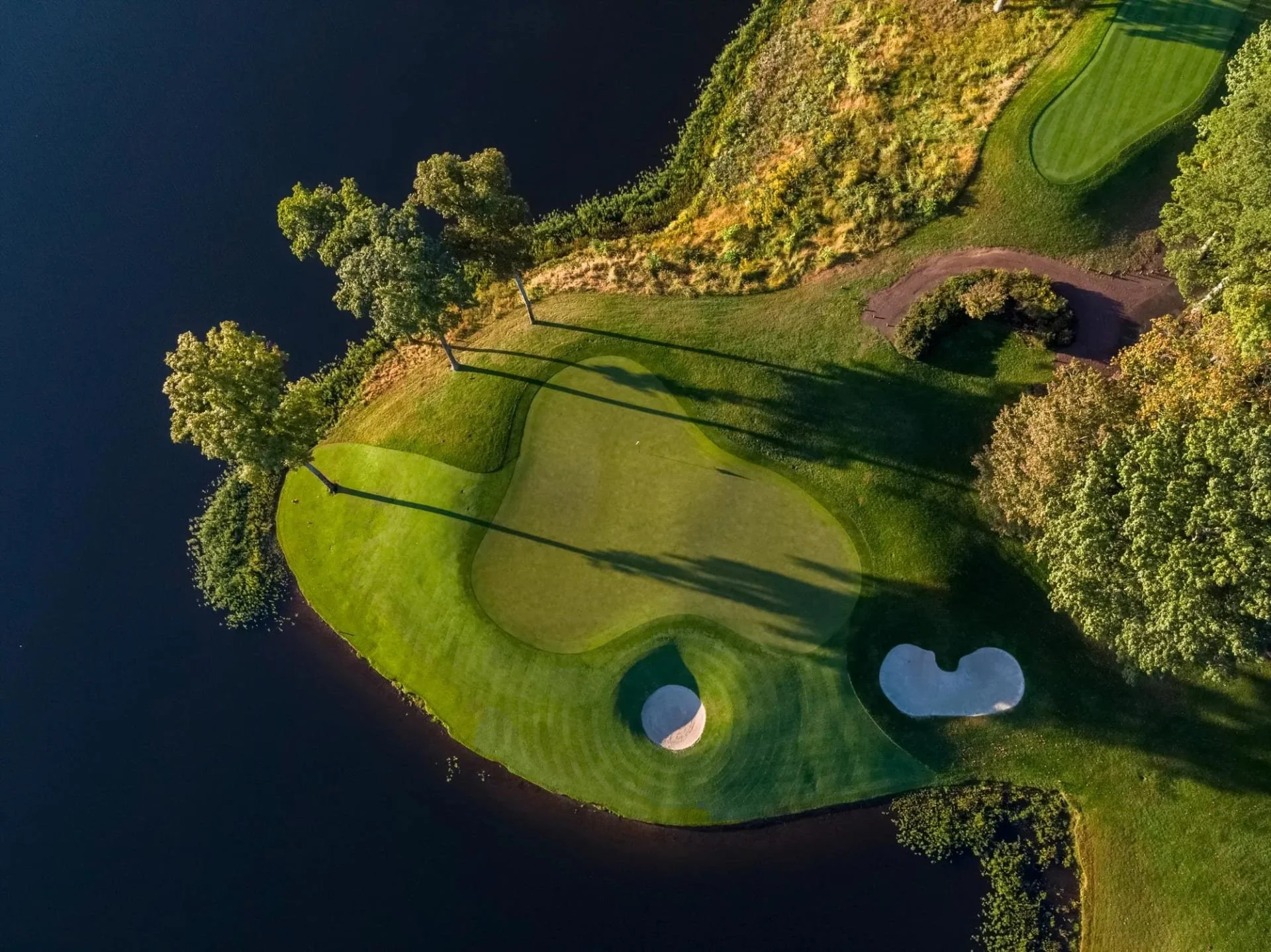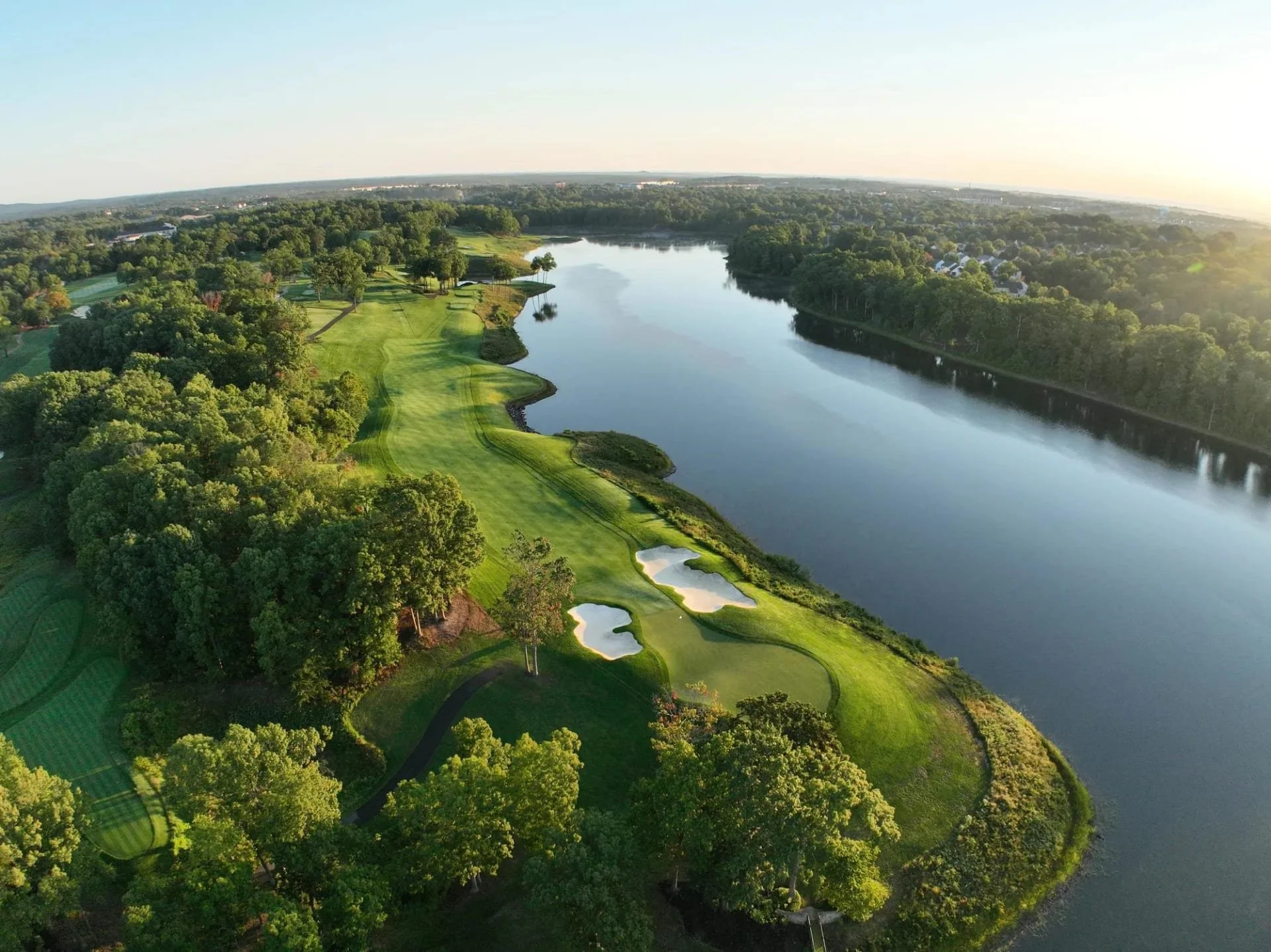ROBERT TRENT JONES GOLF CLUB
Course Architect: Robert Trent Jones (1991), Kyle Phillips (Renovation, 1998-2023).
Year Opened: 1991
Location: Lake Manassas, Virginia
Slope: 136. Rating: 75.9
Par: 72
Yardage: 7,238
Hole-by-Hole: 1 - Par 4 407 Yds 10 - Par 4 382 Yds
2 - Par 4 421 Yds 11 - Par 3 185 Yds
3 - Par 4 449 Yds 12 - Par 5 507 Yds
4 - Par 3 212 Yds 13 - Par 4 454 Yds
5 - Par 5 560 Yds 14 - Par 5 583 Yds
6 - Par 4 436 Yds 15 - Par 4 459 Yds
7 - Par 4 425 Yds 16 - Par 3 166 Yds
8 - Par 5 581 Yds 17 - Par 4 383 Yds
9 - Par 3 199 Yds 18 - Par 4 429 Yds
Par 36 3,690 Yds Par 36 3,548 Yds
Key Events Held: Presidents Cup (1994, 1996, 2000, 2005), LIV Golf (2025),
Quicken Loans National (2015), Solheim Cup (2024).
Awards Won: Ranked #4 - Best in State Rankings - Golf Digest (2005),
Rated 92nd - America's 100 Greatest Courses - Golf Digest (1998),
Ranked 33rd - America's 100 Best Modern Courses - GolfWeek (1997).
HISTORY: While scouting the land for another project, famed architect Robert Trent Jones discovered pristine land along Lake Manassas, just 30 miles west from downtown Washington, D.C. Jones, who designed more than 450 courses around the world, felt that "the terrain is aesthetically perfect." Jones' vision was to design a course for people dedicated to the game of golf and to build a first-class championship golf course.
“I want to tell you how enthusiastic I am about your property." So writes Robert Trent Jones, Sr. in a 1973 letter to the owner of the land.
Since the course opened in 1991, the club has attracted more than 400 members whose stature in the business world and the community are widely known, including president of RTJ, Vernon E. Jordan, Jr., noted Washington attorney. Not only does the course provide a supreme test of golf, its conditioning and beauty has earned it extensive honors. In fact, RTJ was the first course in the Commonwealth of Virginia to be recognized as an Audubon Cooperative Sanctuary.
The center piece of the course is the 850-acre Lake Manassas, visible from nearly every hole, with
eight holes on the back nine running adjacent to it. Only one hole, however, actually forces the player to carry the water, the par-three 11th.
An amazing, 65,000 square foot, red brick, Georgian-style mansion, serves as the clubhouse.
When remembering the past Presidents Cup events held at RTJ, the 1994 clash comes to mind, when Fred Couples clinched the inaugural edition for the United States with a 1-up win over then No. 1 Nick Price. Couples' nine-iron to the 17th green spun back to within 18 inches of the hole, and the U.S. when on to defeat the International squad, 20-12.
Couples again provided the heroics in 1996 when he knocked off Vijay Singh, this time with a long birdie putt on the 17th, as the United States won 16 1/2 to 15 1/2.
The fourth installment of the Presidents Cup returned to RTJ in 2000, with the Americans
avenging their 1998 loss in Australia with the largest margin of victory in the short-lived event, 21 1/2 to 10 1/2. Keys to the victory were the U.S. squad's 9-1 domination in the foursomes, and the lack of fire shown from some the International team, such as Ernie Els, who posted a dismal 0-5 mark.
Kyle Phillips has been the current architect of choice for the RTJ Club since 1998. The last renovation came in 2023. Most of the changes have simply been adjusting to advancements in the game – repositioning of some bunkers and adding some length – but he also opened some vistas to the lake.
In 2005, the Presidents Cup returned as Jack Nicklaus led the Americans to a slim, 18 1/2 to 15/ 1/2 win over the Gary Player-led International squad. Chris DiMarco gained the most points for the U.S. team with 4 1/2, while Retief Goosen matched that number for the Internationals. Tiger Woods had 2 1/2 points.
The Quicken Loans National made its way to RTJ in 2015, as Troy Merritt posted a three-shot win over Ricky Fowler. Merritt took control of the event with a third-round 61 and followed it up with a 67 on Sunday. Merritt clinched the win with a birdie on the last hole.
The 19th edition of the Solheim Cup was held at RTJ Club in 2024. The United States won by three points, their first win since 2017. The U.S. led after each days play and held a four-point lead heading into the Sunday singles play. The Americans won three of the first five matches en route to victory for captain Stacy Lewis. Rose Zhang was the leading point getter for the U.S. with four points while Charley Hull led the Europeans with three.
REVIEW: The course opens with a fairly easy par-four, just 407 yards, doglegging to the right. A three-wood to a wide fairway will leave the player with an uphill second shot to a two-tiered green that slopes quickly back to front.
Uphill is the case on No. 2, as this par-four features a plateau in the fairway, even with the right-side bunker. The green is protected on the left side with a bunker, but this surface needs little protection with huge undulations on all corners with a ridge in the center.
The longest par-four on the front side, the third plays as a slight dogleg right with three massive
bunkers guarding the corner. A large bunker fronts the A-shaped green that slopes back and to the right.
The fourth is the first three-par on the course. This huge greens makes club selection a key ingredient, as the surface offers several possible pin placements. A pond and three bunkers guard the green, while the lake extends to green side on the left.
The par-five fifth is generally a three-shot hole, unless the player can clear the huge fairway bunker on the corner of the dogleg. Even so, the player is then faced with an uphill second shot with two bunkers short and two bunkers at the green on both sides of the fairway. The sensible play is to lay up, leaving a short iron to a relatively small green.
Another dogleg right awaits the player at the sixth. The tee shot must favor the left side, avoiding the cluster of bunkers on the right. From there, a mid-iron to a very small green with three bunkers
surrounding the surface awaits.
Now it's time for a dogleg left, as the seventh hole suggests a tee shot on the right side. But beware, since drives tend to kick left towards the sand. A mid-iron approach to a green that slopes front and left cannot be missed right, as the surface falls sharply off.
The toughest tee shot on the front side must be faced at the eighth, and may leave players scratching their heads as they decide what to do. Luckily, it's a par-five, but don't ease up, seeing that it's 581 yards. On the left is trees, on the right is a dry pond, played as a hazard. Now its time for the second shot, uphill to two separate plateaus. The first section will leave a mid to short iron, while the second fairway, which is guarded by two bunkers, will leave the player with a short pitch. The green is guarded in front by two bunkers on each side, while the surface falls off quickly from back to front.
You are now at the farthest point from the clubhouse, the ninth tee, giving you your first look at Lake Manassas. This downhill par-three features water all along the left side and behind, with a long two-tiered green that slopes to the front. What a way to complete nine holes.
The back nine begins with a benign par-four, or is it? Although only 382 yards, this hole requires accuracy off the tee with water and woods left along with a 25-yard long bunker. A short iron is left to a green with a swale in the center and a surface that slopes to the front.
The 11th, another beautiful par-three, is one of the most photographed holes on the course. The tee shot from the tips must carry water and a steep bank that slopes up to a narrow green that's only 27 paces deep. With water front, left and back and the wind usually playing a significant role, club selection is key.
It's gamble time when you reach the par-five 12th. At 507 yards, this hole is definitely reachable in two, but beware, as the landing area off the tee is tight, with water left and right. The green is elevated, so second and third shots will play longer. Despite the warnings, birdie here is a must, as the remaining holes will prove difficult.
The second-hardest hole and second-longest par-four on the course, the 13th is a brute. Not only does a long bunker guard the right side, but the fairway slopes left and downhill, so driver is not always the correct club off the tee. A long iron is left to a green guarded in front by two large bunkers and water once again, left and back. This large putting surface slopes from back to front with a mound towards the back.
Another opportunity for birdie -- maybe -- lies ahead as you walk to the 14th tee. A solid and long tee shot past the bunkers on the left of this right to left sloping fairway can leave the player with a reasonable chance at reaching the green in two. However, a pond fronting the left side of the green brings the right-side bunkers into play in the bailout area. To make matters worse, the green slopes toward the water and is one of the smallest surfaces on the course.
An outstanding par-four, the 15th stretches 459 yards from the tips and requires a right-to-left ball flight off the tee. A series of bunkers guard the corner of the dogleg, so placement is key. A mid to long iron is left to a green, fronted by sand, that slopes to the front. Miss this green and par will be difficult.
The final par-three on the course, the 16th, is a very photogenic hole, with Lake Manassas once again in the background. Though short, this one-shotter is difficult due to green size and pin placement. Miss short and a huge bunker awaits, while long will get the same result. Be happy with par.
The 17th plays uphill, but is short, so three-metal or a long iron is the choice off the tee. Your first shot must head toward the left side of the fairway, or your approach will be blocked by a single tree, 70 yards shy of the green. Again, two large bunkers guard the entrance to a green that's fairly small with mounds around the edges.
A 240-yard carry to a narrow landing area at the 18th will be one of your final tests. A mid-iron approach should remain to a green that was moved to the left of its original location in order to bring the water into view. Two gaping bunkers front both sides of a very large putting surface that slopes to the front.
FINAL WORD: Getting on this course is next to impossible, but if given the chance, don't pass it up. The shear beauty of the gigantic clubhouse, Lake Manassas and the outstanding architecture make the Robert Trent Jones Golf Club one of the top-five courses in Virginia.
Jones' style here was to guard the greens with large yawning bunkers -- a feature evident on nearly every hole -- and to use the contours of the lakeside to enhance the design.
Eight of the final 10 holes play in full view of Lake Manassas, including two of the best par-threes Jones ever created.
Jones designed some great courses around the world -- Spyglass Hill, Hazeltine, Valderrama and Bellerive among them. However, with perhaps the lone exception his Mauna Kea Golf Course in Hawaii, Robert Trent Jones' self-named club may be the most picturesque of his creations.

